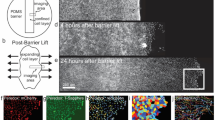Abstract—
Long-term cultivated mammalian cell lines, as a rule, have either an epithelial- or fibroblast-like morphology. The monolayer cell line that we obtained from rat ascites Zajdela hepatoma contains cells of both types, genetically related but phenotypically different. We compared the behaviors of these cells during their migration into the free space of an experimental “wound” under the same cultivation conditions. We measured the following parameters: the dynamics of the cell number in this space, area of cell projection on the substrate, coefficient of cell spreading, rate of cell migration, and proposed parameter W reflecting the cell efficacy in the wound closure. We found that, initially (at the first stage, within 9–10 h), wound closure was due to the cell migration and increased area of cell projection on the substrate. At the second stage, the cell division contributed to a further increase in cell number within the wound. In terms of parameter W, epithelial-like cells moved less chaotically and filled the wound approximately 1.5 times more efficiently than fibroblast-like cells, the motion of which was alike to Brownian. Meanwhile, the average migration rate of epithelial-like cells was about half that of fibroblast-like cells. In the area of the wound that had just closed, the sizes of cells were larger than those of their counterparts outside the wound. We suggest that the increase in cell size was transitory and resulted from changes in the cell functional state during migration to the wound.








Similar content being viewed by others
REFERENCES
Abercrombie, M. and Heaysman, J.E., Observations on the social behaviour of cells in tissue culture, II. Monolayering of fibroblasts, Exp. Cell Res., 1954, vol. 6, pp. 293–306.
Bindschadler, M. and McGrath, J.L., Sheet migration by wounded monolayers as an emergent property of single-cell dynamics, J. Cell Sci., 2007, vol. 120, pp. 876–884.
Catalano, M.G., Fortunati, N., Pugliese, M., Marano, F., Ortoleva, L., Poli, R., Asioli, S., Bandino, A., Palestini, N., Grange, C., Bussolati, B., and Boccuzzi, G., Histone deacetylase inhibition modulates E-cadherin expression and suppresses migration and invasion of anaplastic thyroid cancer cells, J. Clin. Endocrinol. Metab., 2012, vol. 97, pp. E1150–E1159.
Kohn, D.B., Historical perspective on the current renaissance for hematopoietic stem cell gene therapy, Hematol. Oncol. Clin. North. Am., 2017, vol. 31, pp. 721–735.
Krakhmal, N.V., Zavyalova, M.V., Denisov, E.V., Vtorushin, S.V., and Perelmuter, V.M., Cancer invasion: patterns and mechanisms, Acta Naturae, 2015, vol. 7, pp. 18–31.
Kuz’minykh, E.V. and Petrov, Y.P., A simple model for the study of effects of the extracellular matrix on the cell morphology in vitro, Biochim. Biophys. Acta, 2004, vol. 1671, pp. 18–25.
Lin, Y, Gil, C.H., and Yoder, M.C., Differentiation, evaluation, and application of human induced pluripotent stem cell-derived endothelial cells, Arterioscler. Thromb. Vasc. Biol., 2017, vol. 37, pp. 2014–2025.
Liu, Y., Han, Y., Zhang, H., Nie, L., Jiang, Z., Fa, P., Gui, Y., and Cai, Z., Synthetic miRNA-mowers targeting miR-183-96-182 cluster or miR-210 inhibit growth and migration and induce apoptosis in bladder cancer cells, PLoS One, 2012, vol. 7. e52280.
Lomakina, M.E., Changes in the actin cytoskeleton in the dynamics of the cellular edge, which determine the nature of cell migration at the transformation of fibroblasts, Cand. Sci. Dissertation, Moscow, 2011.
Petrov, Yu.P. and Negulyaev, Yu.A., Average cell size is a factor reflecting the interaction of CHO cells during their proliferation, Cell Tissue Biol., 2011, vol. 5, no. 6, pp. 595–602.
Petrov, Yu.P. and Tsupkina, N.V., Morphology of NCTC cells one day after reseeding, Tsitologiia, 2016, vol. 58, no. 1, pp. 35–43.
Petrov, Yu.P. and Tsupkina, N.V., Comparison of the shape of rabbit mesenchymal stromal cells during five passages after production of primary culture, Tsitologiia, 2017, vol. 59, no. 1, pp. 62–68.
Petrov, Yu.P., Teryukova, N.P., Sahenberg, E.I., Ivanov, V.A., and Snopov, S.A., Cell cycle duration in cultured lines of hepatoma Zajdela with signs of cancer stem cells and progenitors, Tsitologiia, 2017, vol. 59, no. 3, pp. 185–193.
Savla, U., Olson, L.E., and Waters, C.M., Mathematical modeling of airway epithelial wound closure during cyclic mechanical strain, J. Appl. Physiol., 2004, vol. 96, pp. 566–574.
Teryukova, N. P., Blinova, G. I., and Ivanov, V. A., Zajdela hepatoma cells cultured in vitro, Cell Tissue Biol., 2013, vol. 7, no. 3, pp. 245–252.
Xu, T., Xiao, D., and Zhang, X., ECRG4 inhibits growth and invasiveness of squamous cell carcinoma of the head and neck in vitro and in vivo, Oncol. Lett., 2013, vol. 5, pp. 1921–1926.
Yang, Z.Y. and Chian, R.C., Development of in vitro maturation techniques for clinical applications, Fertil. Steril., 2017, vol. 108, pp. 577–584.
ACKNOWLEDGMENTS
We sincerely thank E.I. Sachenberg for cultivation of Zajdela hepatoma cells and Yu.A. Negulyaev for help with time-lapse video.
Author information
Authors and Affiliations
Corresponding author
Additional information
Translated by I. Fridlyanskaya
Rights and permissions
About this article
Cite this article
Petrov, Y.P., Teryukova, N.P. & Snopov, S.A. The Behavior of Monolayer Zajdela Hepatoma Cells in an Experimental Wound Space. Cell Tiss. Biol. 12, 426–436 (2018). https://doi.org/10.1134/S1990519X18050048
Received:
Published:
Issue Date:
DOI: https://doi.org/10.1134/S1990519X18050048




